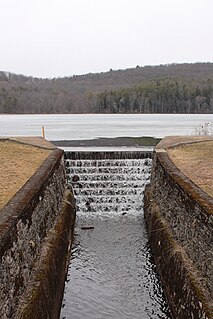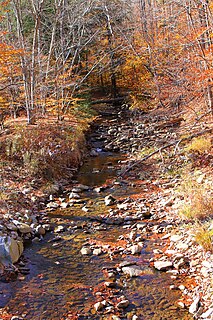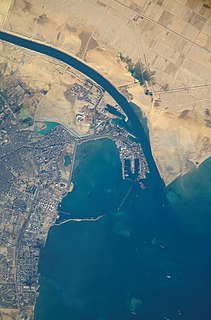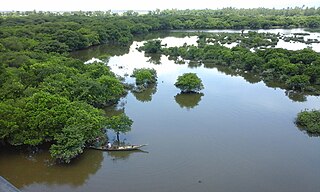
Mehoopany Creek is a tributary of the Susquehanna River in Sullivan and Wyoming counties, Pennsylvania, in the United States. It is approximately 26.8 miles (43.1 km) long. In Sullivan County the creek flows through Colley Township and in Wyoming County it flows through Forkston Township and Mehoopany Township. The stream's watershed has an area of 123 square miles (320 km2). Its major tributaries include Stony Brook and North Fork Mehoopany Creek.
Stony Brook is a tributary of Mehoopany Creek in Wyoming County, Pennsylvania, in the United States. It is approximately 4.3 miles (6.9 km) long and flows through North Branch township and Forkston Township. The brook has a tributary known as Red Brook. Logging was done in the upper reaches of the watershed of Stony Brook in the early 1900s.

Roaring Brook is a tributary of Hunlock Creek in Luzerne County, Pennsylvania, in the United States. It is approximately 5.0 miles (8.0 km) long and flows through Ross Township and Hunlock Township. The watershed of the stream has an area of 6.17 square miles (16.0 km2). It has one named tributary, which is known as Lewis Run. Additionally, a dammed pond known as Harris Pond is located at the stream's headwaters. The Roaring Brook Swamp, which is listed as a Locally Significant Area on the Luzerne County Natural Areas Inventory, is also located in the watershed.

Roaring Run is a tributary of Bowman Creek in Wyoming County, Pennsylvania, in the United States. It is approximately 4.9 miles (7.9 km) long and flows through Forkston Township, Noxen Township, and Monroe Township. It has two named tributaries: Newton Run and South Branch Roaring Run. The watershed of Roaring Run has an area of 11.4 square miles (30 km2). It is designated as a High-Quality Coldwater Fishery and a Migratory Fishery and the stream is Class A Wild Trout Waters. The surficial geology in its vicinity consists of alluvium, alluvial terrace, alluvial fan, bedrock, Wisconsinan Till, and Wisconsinan Ice-Contact Stratified Drift. A bridge carrying Pennsylvania Route 29 crosses the stream.
South Branch Roaring Run is a tributary of Roaring Run in Wyoming County, Pennsylvania, in the United States. It is approximately 2.0 miles (3.2 km) long and flows through Noxen Township and Forkston Township. The watershed of the stream has an area of 3.31 square miles (8.6 km2). The surficial geology in its vicinity consists of bedrock, Wisconsinan Till, Wisconsinan Bouldery Till, Wisconsinan Ice-Contact Stratified Drift, and alluvium. South Branch Roaring Run is classified as Class A Wild Trout Waters.

Cider Run is a tributary of Bowman Creek in Wyoming County, Pennsylvania, in the United States. It is approximately 2.5 miles (4.0 km) long and flows through Forkston Township and Noxen Township. The watershed of the stream has an area of 3.77 square miles (9.8 km2). The stream is not designated as an impaired waterbody. Its watershed is classified as Exceptional Value waters and a Migratory Fishery and the stream is designated as a Wilderness Trout Stream.
Fox Hollow is a tributary of Mehoopany Creek in Wyoming County, Pennsylvania, in the United States. It is approximately 0.8 miles (1.3 km) long and flows through Mehoopany Township. The watershed of the stream has an area of 1.83 square miles (4.7 km2). The Fox Hollow Swamp is listed on A Natural Areas Inventory of Wyoming County.
Rogers Hollow is a tributary of Mehoopany Creek in Wyoming County, Pennsylvania, in the United States. It is approximately 2.2 miles (3.5 km) long and flows through Mehoopany Township. The watershed of the creek has an area of 2.44 square miles (6.3 km2). The creek is classified as a Coldwater Fishery and is in the vicinity of Mehoopany Mountain and Doll Mountain.
Bowman Hollow is a tributary of Mehoopany Creek in Wyoming County, Pennsylvania, in the United States. It is approximately 2.2 miles (3.5 km) long and flows through Forkston Township. The watershed of the stream has an area of 3.08 square miles (8.0 km2). The stream flows over a highly secluded waterfall known as the Bowman Hollow Falls.

White Brook is a tributary of Mehoopany Creek in Wyoming County, Pennsylvania, in the United States. It is approximately 1.8 miles (2.9 km) long and flows through North Branch Township and Forkston Township, in Wyoming County, Pennsylvania, in the United States. The stream's watershed has an area of 1.75 square miles (4.5 km2). The stream is classified as a High-Quality Coldwater Fishery. It has a small waterfall and a hiking path is located nearby.
Scouten Brook is a tributary of Mehoopany Creek in Wyoming County, Pennsylvania, in the United States. It is approximately 2.2 miles (3.5 km) long and flows through Forkston Township. The watershed of the stream has an area of 2.66 square miles (6.9 km2). The stream is designated as a High-Quality Coldwater Fishery and has wild trout. It is one of five large brooks to cut through South Mountain.
Kasson Brook is a tributary of Mehoopany Creek in Wyoming County, Pennsylvania, in the United States. It is approximately 2.7 miles (4.3 km) long and flows through Forkston Township. The watershed of the stream has an area of 4.53 square miles (11.7 km2). The stream is not designated as an impaired waterbody and is classified as a High-Quality Coldwater Fishery. It is one of several streams to cut through South Mountain.
Henry Lott Brook is a tributary of Mehoopany Creek in Wyoming County, Pennsylvania, in the United States. It is approximately 2.4 miles (3.9 km) long and flows through Forkston Township. The watershed of the stream has an area of 2.68 square miles (6.9 km2). The stream is not designated as an impaired waterbody and it is classified as a High-Quality Coldwater Fishery. It is one of five large tributaries of Mehoopany Creek to cut through the Mehoopany Creek-Bowman Creek watershed divide.
Somer Brook is a tributary of Mehoopany Creek in Wyoming County, Pennsylvania, in the United States. It is approximately 3.7 miles (6.0 km) long and flows through Noxen Township and Forkston Township. The watershed of the stream has an area of 4.48 square miles (11.6 km2). The stream is not designated as an impaired waterbody and is classified as a High-Quality Coldwater Fishery. Fauna that have been observed in the stream's vicinity include northern water shrews and trout.
Becker Brook is a tributary of Mehoopany Creek in Wyoming County, Pennsylvania, in the United States. It is approximately 2.6 miles (4.2 km) long and flows through Forkston Township. The watershed of the stream has an area of 2.33 square miles (6.0 km2). The stream is designated as a High-Quality Coldwater Fishery. It is small and secluded, with a swamp known as the Becker Brook Swamp at its headwaters.
South Brook is a tributary of Mehoopany Creek in Luzerne County and Wyoming County, in Pennsylvania, in the United States. It is approximately 6.0 miles (9.7 km) long and flows through Ross Township and Lake Township, Luzerne County, Pennsylvania in Luzerne County and Forkston Township in Wyoming County. The watershed of the stream has an area of 10.1 square miles (26 km2). Wild trout are present in the stream and it has one named tributary, which is known as Opossum Brook.
Opossum Brook is a tributary of South Brook in Luzerne County and Wyoming County, in Pennsylvania, in the United States. It is approximately 4.0 miles (6.4 km) long and flows through Ross Township in Luzerne County and Forkston Township in Wyoming County. The watershed of the stream has an area of 5.13 square miles (13.3 km2). The stream is classified as a High-Quality Coldwater Fishery and has wild trout. The stream has a number of wetlands in its watershed and in some areas is good for birdwatching.
Bellas Brook is a tributary of Mehoopany Creek in Wyoming County, Pennsylvania, in the United States. It is approximately 2.3 miles (3.7 km) long and flows through Forkston Township. The watershed of the stream has an area of 2.71 square miles (7.0 km2). The stream is not designated as an impaired waterbody and is classified as a High-Quality Coldwater Fishery.
Cherry Ridge Run is a tributary of Mehoopany Creek in Luzerne County and Wyoming County, in Pennsylvania, in the United States. It is approximately 1.6 miles (2.6 km) long and flows through Fairmount Township in Luzerne County and Forkston Township in Wyoming County. The watershed of the stream has an area of 1.66 square miles (4.3 km2). The stream is not designated as an impaired waterbody and has a 16 acres (6.5 ha) pond known as Wild Fowl Pond.
Coffee Brook is a tributary of Barnes Brook in Wyoming County and Sullivan County, in Pennsylvania, in the United States. It is approximately 1.1 miles (1.8 km) long and flows through North Branch Township in Wyoming County and Colley Township in Sullivan County. The watershed of the stream has an area of 0.86 square miles (2.2 km2). The stream itself has a high gradient and primarily flows through forested lands. Access is difficult due to a lack of nearby roads and extensive private property signs in the area.
















